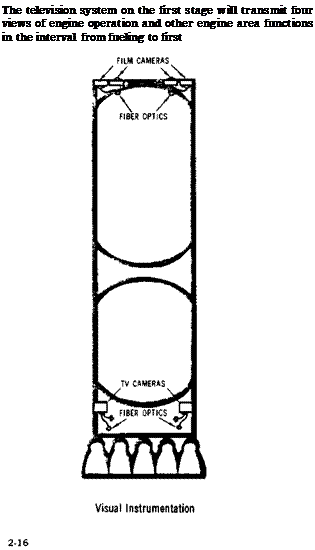FILM CAMERAS
The first stage film cameras provide photographic coverage of the LOX tank interior during launch, flight, and separation. The stage carries four film cameras. The two LOX-viewing cameras will provide color motion pictures to show the following: behavior of the liquid oxygen, possible wave or slosh motions, and cascading or waterfall effects of the liquid from the internal tank structure. The capsules, which contain the cameras, are ejected automatically about 25 seconds after separation and are recovered after descent into the water. First stage flight versions of the camera consist of the LOX tank-viewing configuration plus two direct-viewing stage separation capsules. The installation is in the forward skirt area. The tankviewing optical lenses and the two strobe flash light assemblies are mounted in the LOX tank manhole covers. Connecting the remotely located camera capsules and the flash head are the optical assemblies, consisting of coupling lens attached to the ejection tube, a 9-foot length of fiber optics, and the objective lens mounted in the flash-head assembly. The equipment required to complete the system, such as batteries, power supplies, timer, and synchronizing circuitry, is contained in the environmentally controlled equipment racks or boxes mounted around the interior of the forward skirt structure. The combined timer and synchronizing unit serves

two functions. The digital pulse timer supplies real time correlation pulses which are printed on one edge of the film. The timer also supplies event marker pulses to the opposite edge of the film to record selected significant events such as liftoff, engine shutdown, and stage separation. The synchronizing unit times the intermittent illumination provided by the strobe lamps to coincide with the open portion of the rotating shutter as it passes the motion picture film gate. The capsule assembly consists of the heavy nose section and quartz window, which protect the capsule during re-entry heating and impact on the water. The body of the capsule, including the camera, is sealed and watertight. A paraloon and drag skirt aid its descent and flotation. A radio beacon and flashing light are mounted on the capsule to aid in recovery.
TELEVISION SYSTEM
stage separation. The system utilizes two split fiber optics viewing systems and two cameras. Extremes in radiant heat, acoustics, and vibration prohibit the installation of the cameras in the engine area; therefore, fiber optics bundles are used to transmit the images to the cameras located in the thrust structure. Quartz windows are used to protect the lens. Both nitrogen purging and a wiping action are used to prevent soot buildup on the protective window.
Image enhancement improves the fiber-optical systems by reducing the effects of voids between fibers and broken fibers. An optically flat disc with parallel surfaces rotates behind each objective lens.
The drive motor rotates in synchronism with the master drive motor. A DC to AC inverter energizes the synchronous drive motors. A camera control unit houses amplifiers, fly back, sweep, and other circuits required for the video system. Each vidicon output (30 frames/second) is amplified and sampled every other frame (15 frames/second) by the video register. A 2.5 watt FM transmitter feeds the 7- element yagi antenna array covered by a radome.










